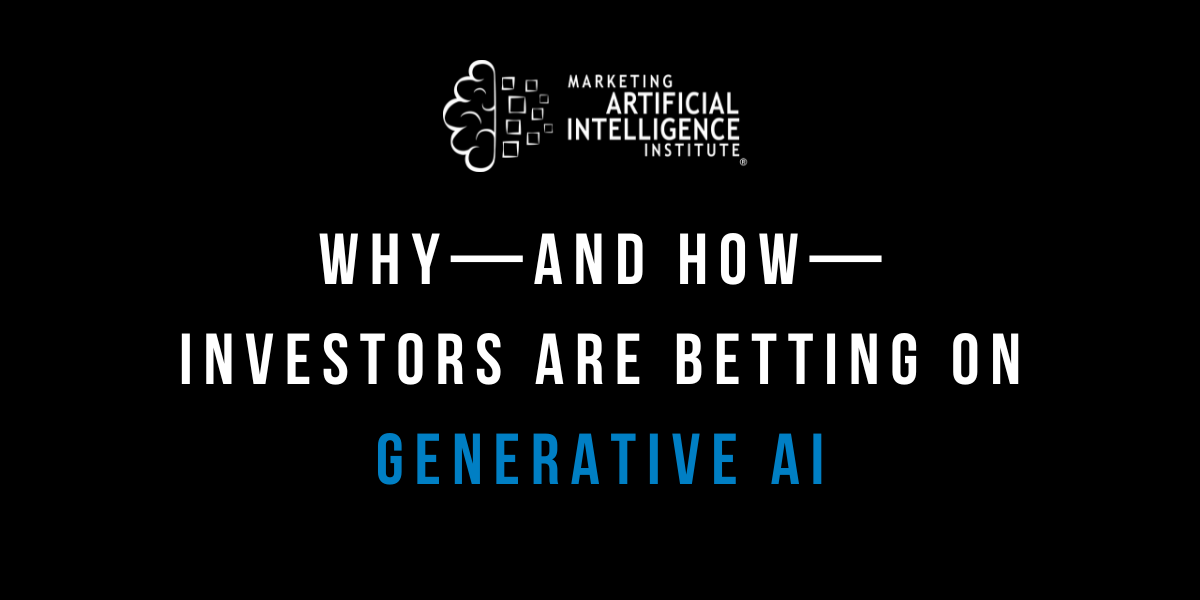Two huge funding announcements show exactly why investors are going crazy over generative AI.
- Inflection AI just raised $1.3 billion in a fresh fundraising round led by Microsoft, Reid Hoffman (who started LinkedIn), Bill Gates, and NVIDIA…
- Runway, which builds generative AI tools for creators, announced a $141 million extension to its Series C funding round from companies like Google, NVIDIA, and Salesforce Ventures…
And it’s because they’re building the future of generative AI in very unique ways.
Why it matters: The size of generative AI’s potential impact cannot be overstated. McKinsey estimates that generative AI could add $2.6 trillion to $4.4 trillion in annual value to the global economy. That kind of market impact has investors salivating. Whoever bets on the right generative AI horse stands to make a killing.
Connecting the dots: In Episode 54 of the Marketing AI Show, Marketing AI Institute founder/CEO Paul Roetzer shared with me why these companies in particular are important—and how to think about the generative AI investment landscape.
- There are three broad types of investable generative AI companies. First, you have the infrastructure companies that provide the chips and cloud capabilities on which all generative AI relies to function. (Think: NVIDIA, Google, AWS, and Microsoft.) Second, you have foundation model companies—the companies building the base models that power generative AI apps. Third, you have the application layer companies themselves—companies like Writer and Jasper building on top of models.
- Inflection and Runway play in the foundation model and application spaces. Inflection is building its own massive, sophisticated large language model, then running its Pi app on that model. Runway’s Gen-1 and Gen-2 image models power a range of apps in its creative suite. So, both companies straddle the foundation model and application layer categories.
- Building and training models is expensive. The reason these companies are raising so much money is because they need to invest massively in infrastructure like chips/GPUs and cloud services, says Roetzer. For context, OpenAI CEO Sam Altman estimated it cost $100 million to train GPT-4 alone. Foundation model companies are trying to outgun OpenAI, so they need very deep pockets.
- Because of this, there are only a handful of foundation model companies. Given the high barrier to entry, there are only a handful of foundation model companies, such as Inflection, OpenAI, and Cohere. For investors, betting on a handful of foundation model companies appears to be a better bet than guessing which of the thousands of apps built on top of them will win the market.
How to take action: Let’s face it: None of us are probably writing checks for $1.5 billion anytime soon. So how can you use this information?
Well, you’re probably thinking about how to bet on AI companies in other ways. For instance, which AI companies should you be including in your tech stack? How can you be sure the AI tool you onboard your team to will be around in 12 months? Roetzer has some advice, based on Marketing AI Institute’s work advising companies on their AI tech stacks.
Understand that you’re probably going to take two paths in parallel, especially if you’re a large enterprise:
- In the short term, you’re likely moving forward with a few affordable AI tools for core use cases. (For instance, onboarding your marketing team with AI writing apps like Writer or Jasper.)
- In the long term, you’re developing a larger AI strategy and vision. For enterprises, that might look like figuring out your play with large language models, since you’ll likely need to customize an existing one to your needs or build your own. For these types of needs, look at the technology you already use. If you’re a Google, Microsoft, or AWS customer already, they’re your first call when it comes to bigger AI transformation.
Don’t get left behind…
You can get ahead of AI-driven disruption—and fast—with our Piloting AI for Marketers course series, a series of 17 on-demand courses designed as a step-by-step learning journey for marketers and business leaders to increase productivity and performance with artificial intelligence.
The course series contains 7+ hours of learning, dozens of AI use cases and vendors, a collection of templates, course quizzes, a final exam, and a Professional Certificate upon completion.
After taking Piloting AI for Marketers, you’ll:
- Understand how to advance your career and transform your business with AI.
- Have 100+ use cases for AI in marketing—and learn how to identify and prioritize your own use cases.
- Discover 70+ AI vendors across different marketing categories that you can begin piloting today.
Mike Kaput
As Chief Content Officer, Mike Kaput uses content marketing, marketing strategy, and marketing technology to grow and scale traffic, leads, and revenue for Marketing AI Institute. Mike is the co-author of Marketing Artificial Intelligence: AI, Marketing and the Future of Business (Matt Holt Books, 2022). See Mike's full bio.



